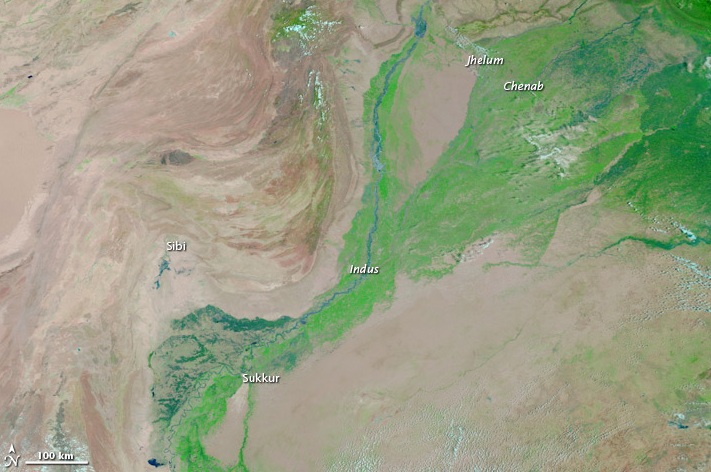|
Flooding in Pakistan-
Report from Earth
Observatory http://earthobservatory.nasa.gov/NaturalHazards/view.php?id=45200
|

Image acquired on 11 August 2010
|

Image acquired on 10 July 2010
|
By early August
2010, two weeks of
devastating monsoon
rains had transformed
the landscape of
Pakistan, pushing rivers
over their banks,
inundating villages,
washing away bridges and
roads, destroying crops,
and killing livestock.
By August 12, 2010, more
than 1,600 people had
perished, according to
news reports, and the
United Nations Office
for the Coordination of
Humanitarian Affairs (OCHA)
estimated that more than
14 million people had
been affected in some
way.
To the Moderate
Resolution Imaging
Spectroradiometer
(MODIS) on NASA’s
Terra satellite, the
impact of Pakistan’s
floods was most obvious
along the major rivers.
These images use a
combination of infrared
and visible light to
increase the contrast
between water and land.
Water appears in varying
shades of blue, and
clouds appear in varying
shades of blue-green.
Vegetation is green, and
bare ground is pinkish
brown. The top image is
from August 11, 2010,
after two weeks of
flooding had devastated
the country. For
comparison, the bottom
image shows the same
region one month before,
on July 10, 2010.
In the image
from July 10, the
relatively narrow Indus
River remains confined
to its banks, and the
Jhelum and Chenab
Rivers, which flow into
the Indus, are barely
discernible. In the
image from August 11,
all three rivers are
swollen, and the Indus
River has pushed over
its banks even before it
meets the tributaries
flowing from the east.
By August 11,
floodwaters, which
initially hit
northern Pakistan the hardest,
had spread southward
along the Indus.
Northwest of the bend in
that river, standing
water is apparent around
the city of Sibi. South
of Sukkur, where a
barrage modifies river
flow, the Indus narrows
somewhat, but flooding
is apparent there as
well. In fact, MODIS
acquired this image as
the Indus was
rapidly rising south of Sukkur.
The torrential
monsoon rains that
devastated Pakistan in
late July and early
August 2010 were part of
a
larger pattern of unusually
heavy monsoon rains
across Asia, perhaps
driven at least partly
by La Niña.
OCHA stated that
the scale of destruction
from Pakistan’s monsoon
flooding surpassed the
devastation from the
2004 Indian Ocean
tsunami, the 2005
northern Pakistan
earthquake, and the 2010
Haiti
earthquake combined. As
monsoon season was not
over, OCHA described the
situation as an
“evolving emergency.”
Multiple relief efforts,
however, were already
underway. U.S. troops
worked with Pakistan’s
military to deliver aid.
The World Food Programme
and partner agencies had
delivered more than
4,350 metric tons of
food to at least 370,000
people, and the United
Nations Children’s Fund
(UNICEF) had delivered
clean drinking water to
more than a million
residents.
1.
References
2.
Agence France-Presse. (2010, August 8).
U.N. to launch appeal for Pakistan flood
disaster. Accessed August 12,
2010.
3.
Aziz, F. (2010, August 12).
Pakistani president tries to comfort flood
victims. Reuters. Accessed
August 12, 2010.
4.
Brummitt, C. (2010, August 11).
U.S. aid winning friends in flood-ravaged
Pakistan. Associated Press.
Accessed August 12,
2010.
5.
United Nations Office for the Coordination of Humanitarian
Affairs. (2010, August
12).
Pakistan: Initial floods emergency response
plan requires $459.7
million. ReliefWeb. Accessed
August 12, 2010.
NASA images
courtesy the
MODIS Rapid Response Team at NASA GSFC.
Caption by Michon Scott.
Instrument:
Terra - MODIS
|